Multi-Platform Influencer Strategies: Maximizing Reach Across All Channels
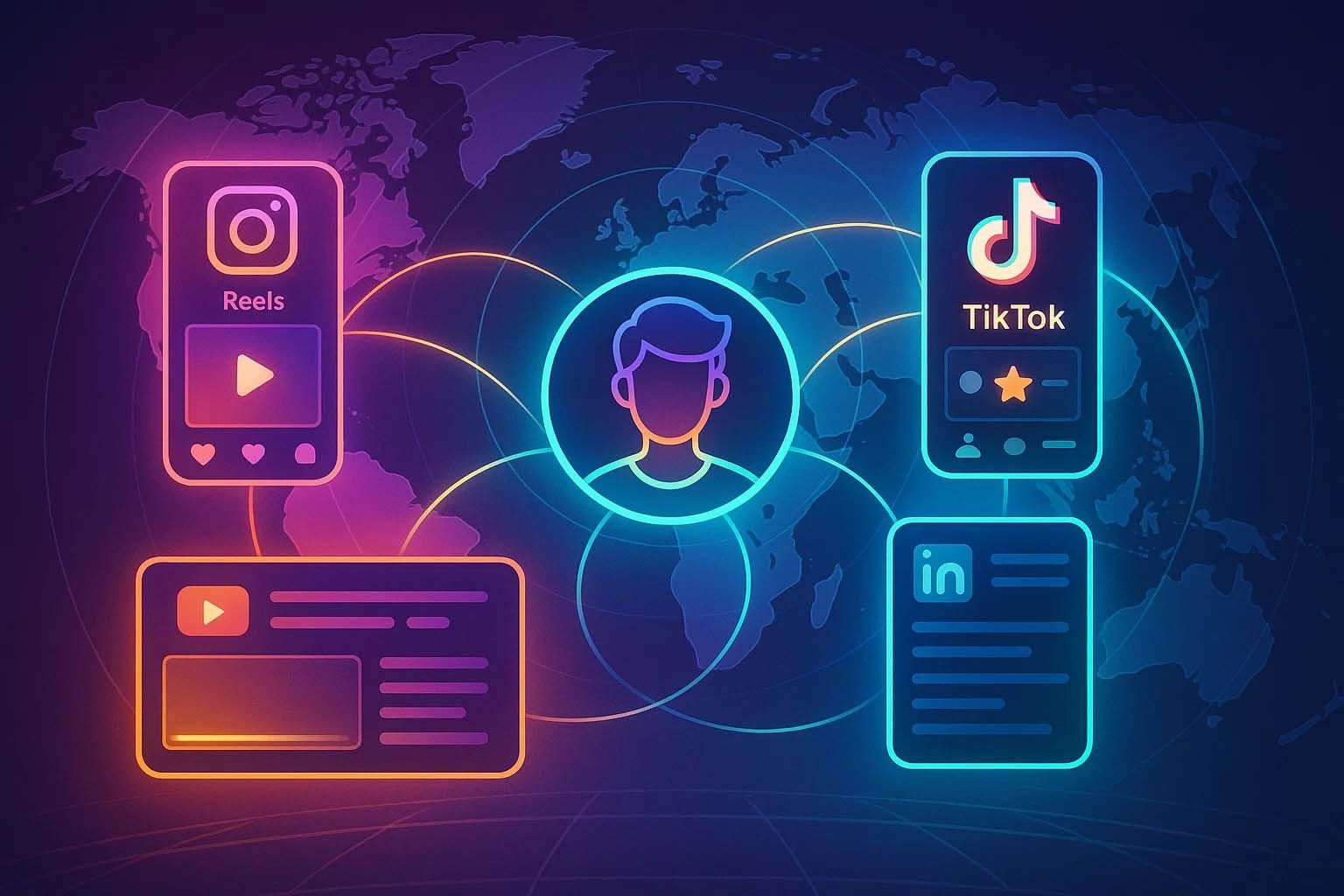
The digital marketing landscape has transformed dramatically, with influencer marketing emerging as a cornerstone of successful brand strategies. Today's marketing industry operates within a $236 billion earned media value ecosystem, where consumers seamlessly navigate between Instagram, TikTok, YouTube, and LinkedIn throughout their customer journey. As brands collaborate with influencers across different platforms, the need for sophisticated multi-platform strategies has never been more critical.
Modern audiences don't limit themselves to single social media platforms. Consumers engage with brands across multiple digital platforms simultaneously. This behavioral shift demands that marketing efforts evolve beyond traditional single-channel approaches to embrace comprehensive influencer strategies that maximize visibility and conversion potential.
Influencer Marketing Strategy Across Multi Channel Platforms
The evolution from single-channel to multi-platform strategy represents a fundamental shift in how brands approach influencer partnerships. Unlike traditional marketing campaigns that focus on one primary channel, effective influencer marketing campaigns now require coordinated efforts across various platforms for influencer marketing to ensure maximum impact and reach a broader audience.
Multi-channel strategies recognize that different platforms serve distinct functions in the customer journey. According to HubSpot’s State of Marketing Report, 26% of marketers believe that data enables them to drive higher ROI through multichannel marketing. Although specific figures on engagement rate increases are unavailable, brands using multiple marketing platforms consistently report superior campaign performance and reach—thanks to optimized content delivery and consistent messaging across channels.
Role of Platforms in Influencer Marketing Campaigns
Each social media platform offers distinct advantages that savvy marketers can leverage for optimal results. Understanding the specifics of each platform becomes crucial when running a successful influencer marketing campaign:
-
Instagram: Excels at visual storytelling and brand awareness, with sophisticated shopping features enabling direct conversion paths
-
TikTok: Revolutionized viral content creation, offering unparalleled organic reach potential through its algorithm that favors authentic, entertaining content
-
YouTube: Serves as the premier platform for long-form content and detailed product demonstrations, functioning as both social media and search engine
-
LinkedIn: Dominates B2B influencer marketing, where professional credibility and industry expertise drive successful campaigns
According to Influencer Marketing Hub’s TikTok statistics, TikTok content achieves significantly higher engagement rates compared to other social media platforms. Accounts with over 1 million followers on TikTok average a 10.53% engagement rate, while comparable Instagram accounts see only 0.95%. For smaller creators with 1K–5K followers, TikTok delivers 15.04% engagement, versus 4.21% on Instagram. These numbers highlight TikTok’s dominance in engagement, particularly for nano- and micro-influencers.
Difference Between Multi Channel and Cross Channel Influencer Strategies
Understanding the distinction between multi-channel and cross-channel approaches is crucial for marketing success:
Multi-channel strategies involve running separate campaigns across different platforms, each tailored to the platform's specific audience and content format. For example, a beauty brand might partner with influencers to create Instagram tutorials, TikTok transformation videos, and YouTube in-depth reviews.
Cross-channel strategies create interconnected campaigns where social media content works synergistically. A successful cross-channel campaign might feature an influencer teasing content on Instagram Stories, releasing the full video on YouTube, and creating follow-up TikTok content that drives traffic back to the original video.
How to Optimize Content for Each Social Media Platform?
Content optimization requires understanding platform nuances and adapting accordingly:
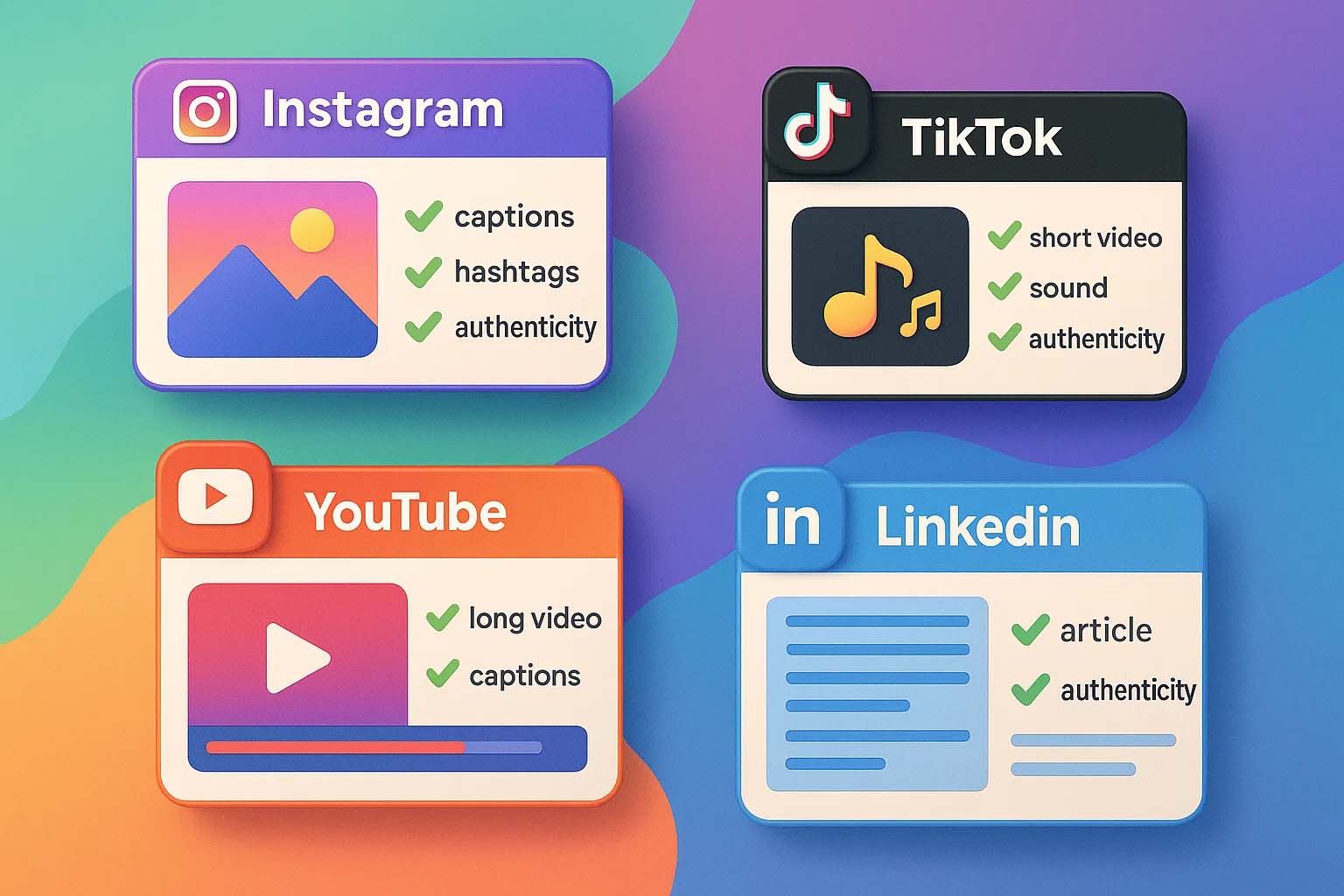
Instagram Optimization:
-
Prioritize high-quality visuals with optimal posting times between 11 AM and 1 PM on weekdays
-
Utilize trending audio and hashtags in Stories and Reels
-
Craft engaging captions that encourage interaction
TikTok Content Strategy:
-
Focus on authenticity and trend participation
-
Ensure first few seconds capture immediate attention
-
Leverage trending sounds, challenges, and formats
YouTube Best Practices:
-
Develop comprehensive storytelling through longer-form content
-
Optimize descriptions and thumbnails for search functionality
-
Maintain consistent upload schedules
Choosing the Right Influencer for Each Marketing Channel
Influencer selection represents perhaps the most critical aspect of successful campaigns. The influencer marketing industry has evolved to recognize that the right influencer for Instagram might not necessarily excel on TikTok, making platform-specific selection essential.
According to Mediakix, 89% of marketers report that influencer marketing delivers ROI equal to or better than other marketing channels. To maximize campaign performance across platforms, marketers should:
-
Analyze engagement quality rather than relying only on follower counts.
-
Leverage micro-influencers (10K–100K followers) for superior engagement on Instagram and TikTok.
-
Use macro-influencers to maximize impact on YouTube, where longer-form content performs well.
-
Prioritize platforms where target audiences are most active, ensuring alignment with consumer behavior.
5 Key Benefits of Using Multi-Platform Influencer Campaigns
Multi-platform approaches deliver measurable advantages that single-channel strategies cannot match. These benefits compound when executed strategically, creating synergistic effects that amplify overall marketing impact.
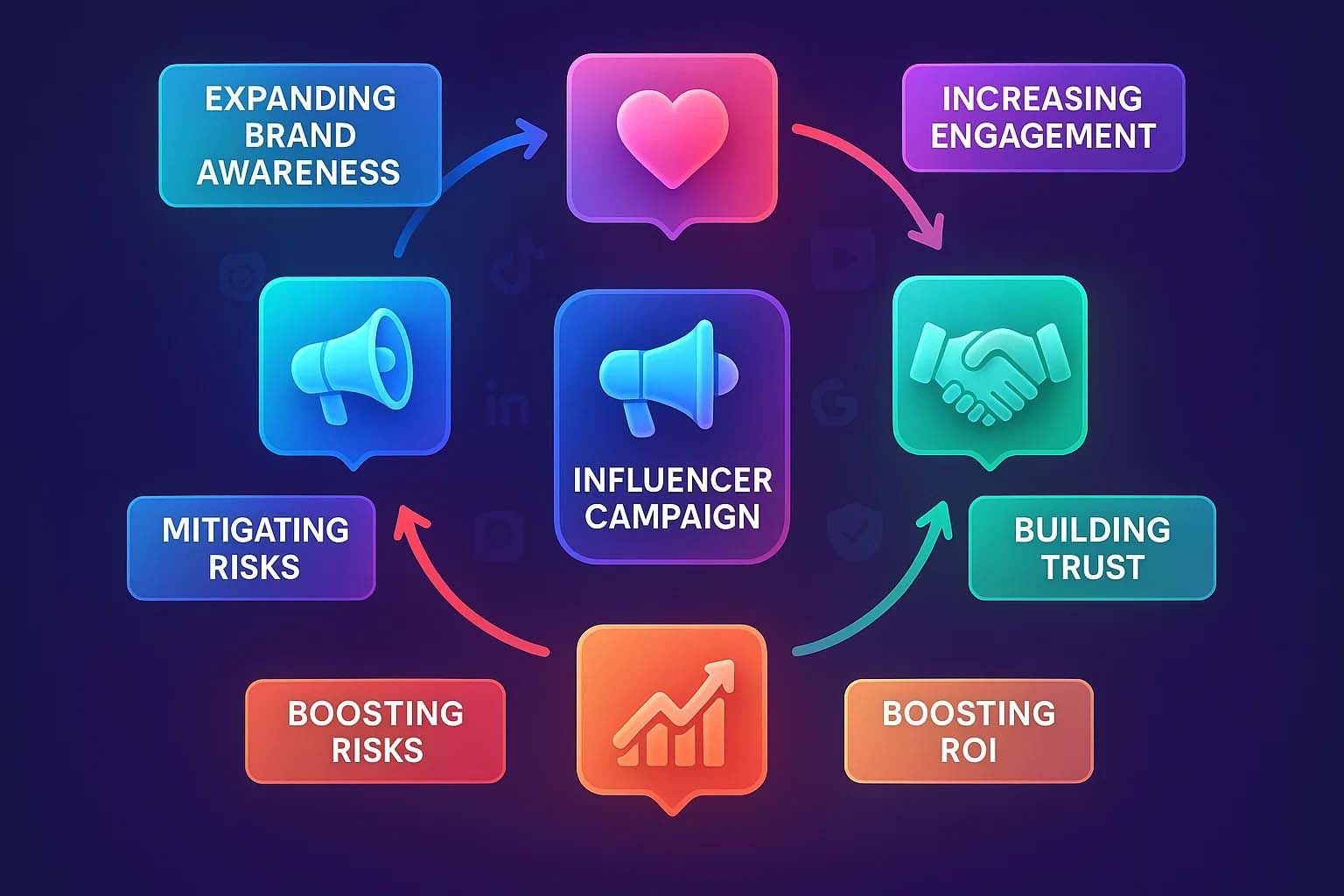
Expanding Brand Awareness Through Social Media Marketing Channels
Multi-platform strategies exponentially expand brand awareness by capturing audiences at different touchpoints. Consumers need multiple exposures across platforms before making purchasing decisions, with brand awareness increasing by 68% when campaigns span three or more platforms.
The compounding effect occurs because different platforms capture audiences in various mindsets - Instagram users might discover a brand through lifestyle posts, while TikTok users encounter it through entertainment-focused content, and LinkedIn users see it in professional contexts.
Increasing Engagement Quality Across Social Media Platforms
Platform diversity enables deeper audience engagement by leveraging each platform's unique interaction mechanisms. Multi-platform campaigns achieve 43% higher engagement quality scores compared to single-platform efforts.
Building Trust Through Authentic Influencer Marketing Strategies
Authenticity emerges naturally when influencer collaborations span multiple platforms, as audiences witness consistent brand partnerships across their preferred channels. According to Edelman's Trust Barometer, 67% of consumers trust brands more when they see consistent relationships with influencers across platforms.
Boosting ROI with Optimized Influencer Marketing Campaigns
Multi-platform campaigns optimize ROI through efficient resource allocation and cross-platform content amplification. Brands earn $5.78 for every dollar spent on multi-platform influencer campaigns, compared to $4.12 for single-platform efforts.
Benefits of Using Multi Channel Strategies for Risk Mitigation
Algorithm changes can devastate single-channel strategies overnight. Multi-platform approaches provide crucial risk mitigation by distributing exposure across various channels. Historical data shows that during Facebook's major algorithm updates in 2018, brands with diversified strategies maintained 73% of their previous engagement levels, while single-platform brands experienced 45% decreases.
Core Elements of Successful Influencer Marketing Campaigns
Building effective multi-platform campaigns requires understanding fundamental elements that drive success across all digital platforms. These building blocks ensure that marketing efforts translate into measurable results while maintaining authenticity.
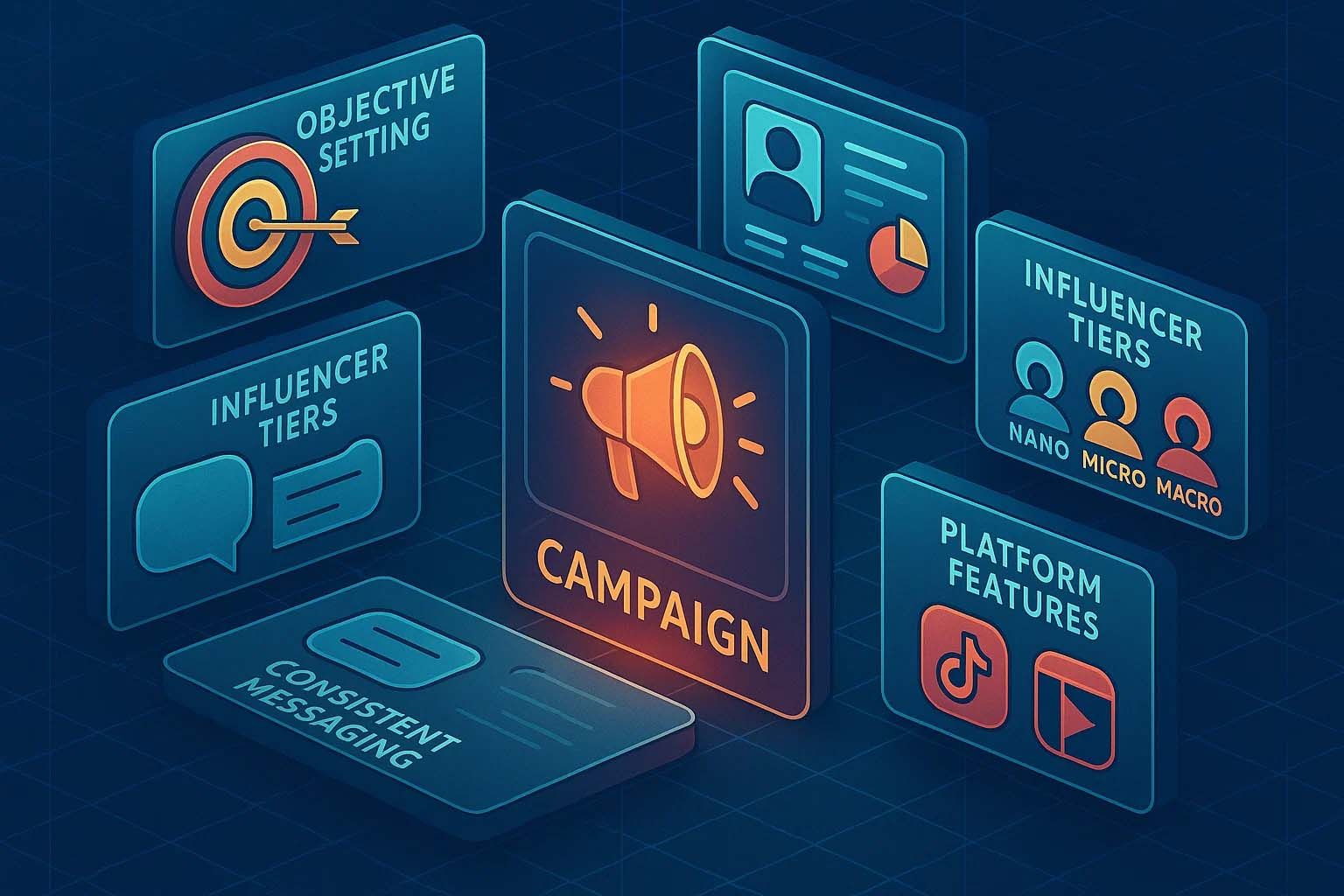
Defining Clear Objectives in Influencer Marketing Strategy
Successful campaigns begin with precisely defined, measurable objectives that align with broader marketing goals. According to Campaign Monitor, campaigns with clearly defined objectives achieve 67% higher success rates than those with vague goals.
Finding the Right Influencer Across Platforms
As influencer marketing has become increasingly sophisticated, the platform for influencer marketing campaigns now requires comprehensive analytics. Tools like AspireIQ and Upfluence help brands identify creators who can naturally integrate brand messaging while maintaining their unique voice across different platforms.
Key selection criteria include:
-
Authentic engagement patterns
-
Consistent content quality
-
Audience demographics matching target markets
-
Platform-specific expertise and performance metrics
Influencer Tier Optimization for Campaign Success
Understanding when to leverage different influencer tiers across marketing channels maximizes campaign effectiveness:
-
Nano-influencers (1K-10K): Excel at hyper-local penetration with 7.2% average engagement rates
-
Micro-influencers (10K-100K): Represent the sweet spot combining substantial reach with maintained authenticity
-
Macro-influencers: Effective for platforms requiring broader reach and professional content
Leveraging Platform Features to Optimize Campaign Performance
Each platform offers unique features that ai-powered influencer marketing strategies can leverage:
Instagram Features:
-
Shopping tags for direct product discovery
-
Stories highlights for lasting visibility
-
Reels for higher organic reach
TikTok Capabilities:
-
Duet and stitch features for user-generated content
-
Trending hashtags and sounds for amplified visibility
-
Challenge formats for viral potential
YouTube Tools:
-
End screens and cards for multiple conversion pathways
-
Search optimization for long-term organic traffic
-
Comprehensive analytics for performance tracking
Budgeting for Influencer Marketing Campaigns Across Platforms
Strategic budget allocation requires understanding platform-specific costs, audience values, and conversion potentials while maintaining flexibility for trend-driven opportunities.
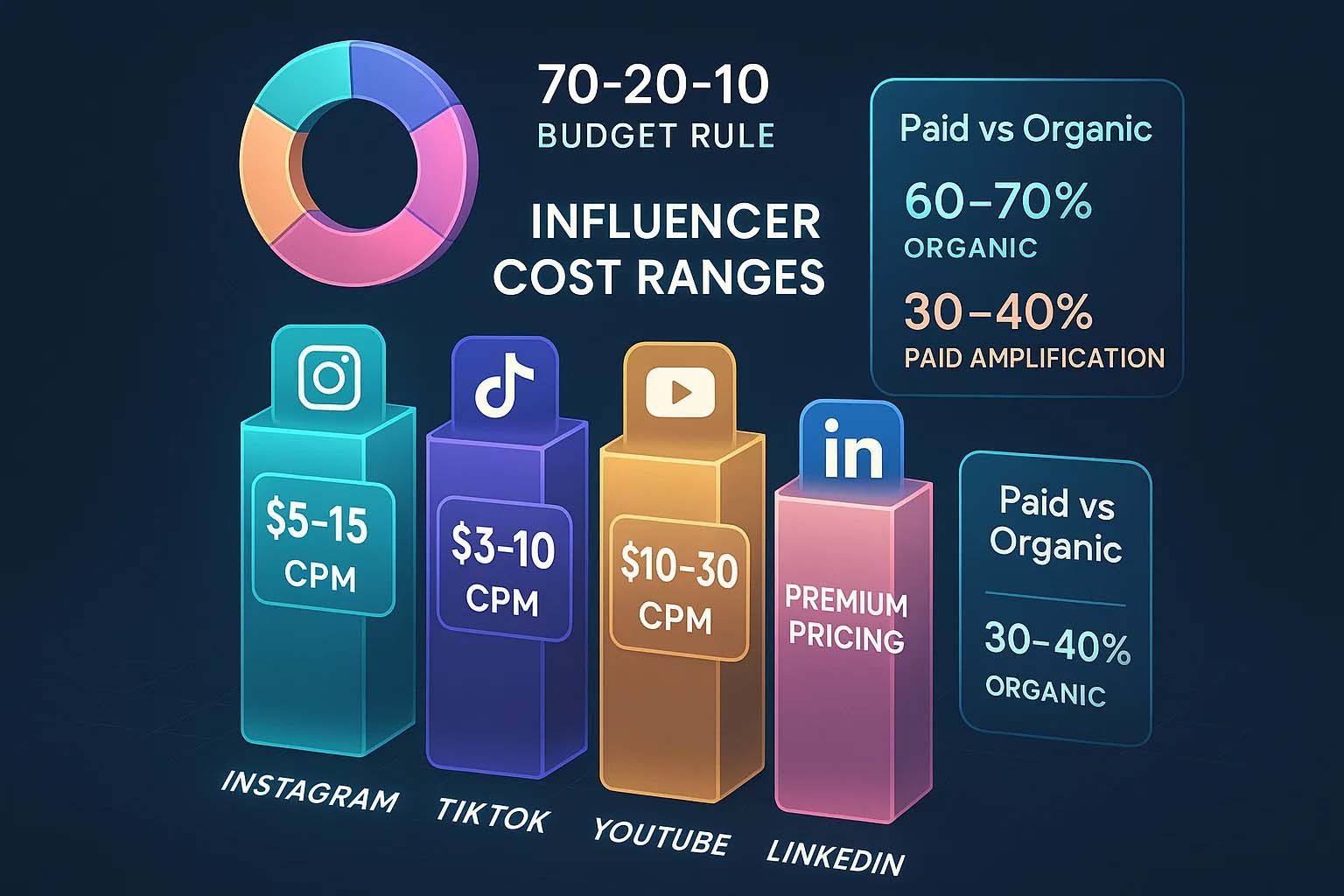
Cost Breakdown by Social Media Platform (According to Influencer Marketing Hub’s 2025 influencer cost guide):
-
Influencer CPMs vary by platform—estimated at $5–$15 on Instagram, $3–$10 on TikTok, and $10–$30 on YouTube
-
Separate research from Sprout Social indicates TikTok influencers charge around $10 per 1,000 followers for a sponsored post.
Effective Budget Allocation Strategies
-
70% towards proven high-performing platforms with strong ROI.
-
20% on secondary platforms showing growth potential.
-
10% reserved for experimental or emerging channels.
Balancing Paid and Organic Approaches
-
Aim for 60–70% organic content, focusing on authentic influencer creativity.
-
Use 30–40% of the budget to amplify top-performing content via paid promotion.
Measuring Success in Influencer Marketing Strategy Across Platforms
Comprehensive measurement strategies enable optimization and demonstrate campaign value through both quantitative metrics and qualitative insights.
Core KPIs for Multi-Platform Campaigns
Primary KPIs must align with campaign objectives while providing comparable metrics:
Universal Metrics:
-
Engagement rate (calculated differently per platform)
-
Reach and impressions for baseline awareness
-
Click-through rates and conversion tracking
-
Brand sentiment analysis through comment quality
Platform-Specific Indicators:
-
Instagram: Save rates, Stories completion
-
TikTok: Video completion rates, share velocity
-
YouTube: Watch time, audience retention
-
LinkedIn: Lead generation, professional engagement
Advanced Attribution and AI Optimization
Multi-touch attribution becomes essential when campaigns span multiple platforms. Advanced tools enable:
-
UTM codes for detailed traffic source tracking
-
Custom landing pages for accurate attribution
-
AI-powered platforms that analyze performance patterns
-
Predictive analytics for campaign optimization
Modern AI-powered influencer platforms like Klear, Upfluence, Yoloco and AspireIQ use machine learning to match brands with optimal influencers based on audience overlap and historical performance.
Tips to Optimize Multi-Platform Influencer Marketing Strategies
Optimization requires ongoing attention to platform evolution, audience preferences, and performance data while balancing proven strategies with experimental approaches.
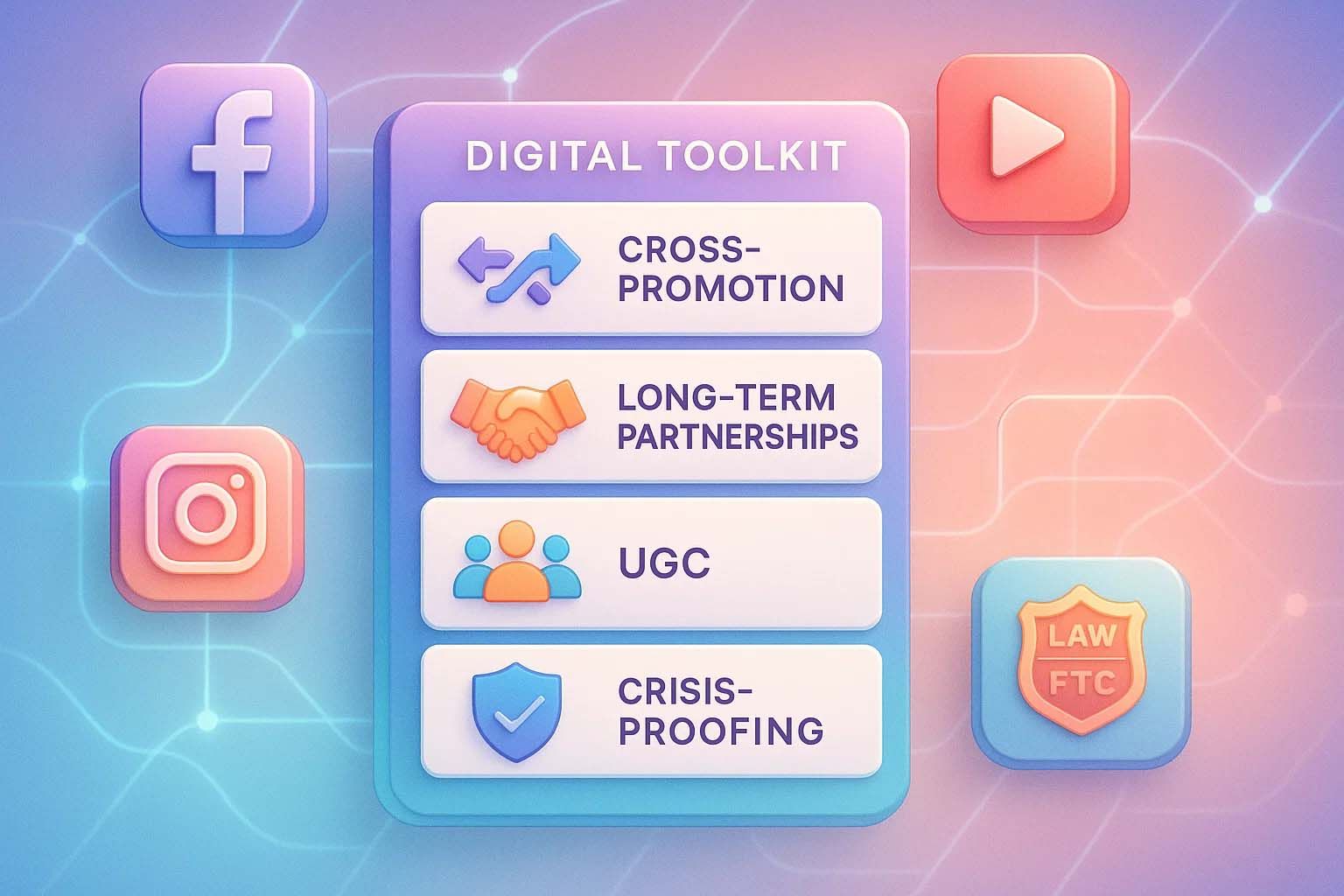
Cross-Promotion and Long-Term Relationships
Strategic cross-promotion amplifies reach by leveraging each platform's unique strengths. Instagram Stories can tease YouTube videos, TikTok content can drive Instagram traffic, and LinkedIn articles provide business context for consumer campaigns.
Ambassador programs deliver superior results, with long-term relationships with influencers generating 73% higher engagement rates on average. When you add influencer partnerships to long-term strategies, authenticity increases because relationships become genuine rather than transactional.
Leveraging User-Generated Content
User-generated content extends campaign reach organically while providing authentic social proof. Successful UGC campaigns create frameworks that encourage audience participation across online and offline platforms.
Brands can follow influencers' lead in creating hashtag campaigns that work particularly well on visual platforms, where audiences naturally create imitation content that showcases products better than traditional advertising.
Crisis-Proofing and Compliance
Algorithm changes require diversification strategies that include:
-
Maintaining presence across multiple platforms
-
Building email lists from social media followers
-
Creating evergreen content for sustained value
-
Understanding FTC guidelines and platform-specific disclosure requirements
Future of Influencer Marketing Strategies Across Platforms
The influencer marketing landscape continues evolving rapidly, with emerging technologies reshaping strategic approaches. Among the top marketing trends, AI-driven tools and social commerce integration represent the most significant developments.
AI and Social Commerce Integration
Artificial intelligence revolutionizes influencer discovery through sophisticated matching algorithms and performance prediction. Advanced AI tools now predict campaign performance with 85% accuracy, while social commerce features like Instagram Shopping and TikTok Shop transform awareness campaigns into direct-sales drivers.
Holistic Digital Integration
Future success requires integrating influencer content with SEO and paid media for amplified results. Influencers can help create authentic social proof for advertising campaigns while generating backlinks that improve search rankings.
Maximizing Impact Through Strategic Multi-Platform Excellence
The evolution of influencer marketing strategies across multiple social media platforms represents a fundamental shift toward comprehensive ecosystem approaches. Successful brands leverage each platform's unique strengths while maintaining authentic partnerships that resonate with diverse audiences.
Frequently Asked Questions About Multi-Platform Influencer Marketing
How do I choose the right influencer marketing platform for my campaigns?
When selecting an influencer marketing platform, look for tools that help you identify the platforms where your target audience is most active. The best platforms offer comprehensive analytics, influencer discovery features, and campaign management tools. Popular options include Yoloco, AspireIQ, Upfluence, and Klear, which use AI to match brands with creators who can promote products or services authentically while tracking influencer performance across multiple channels.
How can I create content that resonates across different social media platforms?
To create engaging content that works across platforms, you must understand the nuances of each platform while maintaining consistent brand messaging. Focus on content across different formats - short-form videos for TikTok, high-quality visuals for Instagram, and longer educational content for YouTube. The key is adapting your message to each platform's unique audience expectations while ensuring authenticity.
What should I look for when evaluating influencer marketing efforts?
When you look for influencers and evaluate campaign success, focus on engagement quality over follower count. Track metrics like authentic audience interaction, content performance across different platforms, and how well influencers can naturally integrate your brand message. Use tracking influencer analytics to measure reach, engagement rates, conversion rates, and long-term brand awareness impact.
How do I identify the platforms that will work best for my brand?
Start by analyzing where your target audience spends their time and how they prefer to consume content. Consider your product type - visual products work well on Instagram, while B2B services might perform better on LinkedIn. Follow influencers in your niche to understand which platforms generate the most engagement for similar brands, and test small campaigns before investing heavily.
How can I integrate influencer marketing with other digital marketing channels?
Successful integration involves combining influencer content with email marketing, SEO, and paid advertising. Use influencer-created content as social proof in your email campaigns, leverage their content for paid ads, and encourage them to create content that can be repurposed across your owned media channels. This multi-channel approach amplifies your influencer marketing efforts and maximizes ROI.
29.08.2025
116 article view
Similar articles
01.09.2025
Psychology Behind Influencer Marketing: Why People Trust Influencers
Understanding the psychology behind influencer marketing has become crucial for brands seeking authentic...
23.12.2024
Complete Guide to Free YouTube Analytics Tool
YouTube Analytics transforms raw viewership data into actionable insights that can dramatically impact...
26.09.2024
Characteristics and values of Z generation
Who is Generation Z and Their Definition The term "Gen Z" describes those who were born from the late...